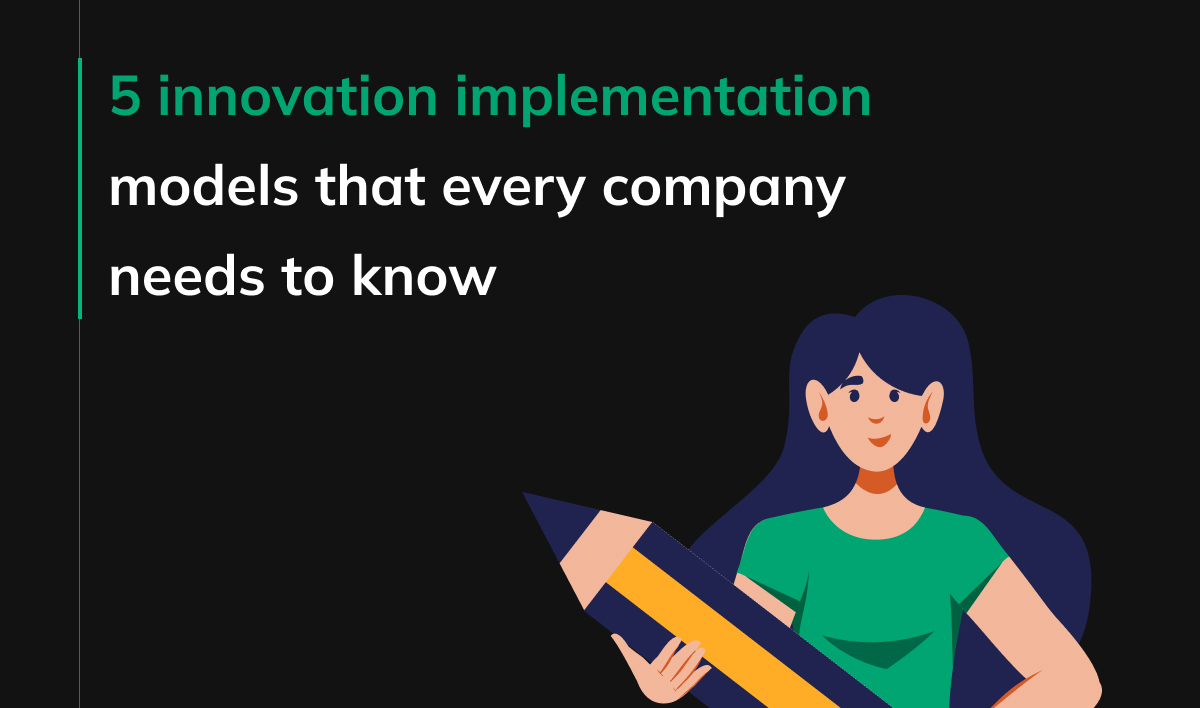How to implement innovation in your company? 5 ways

From my Agile Coach and Agile Consultant experience, I have learned that no one is genuinely interested in “adopting Agile”. No one is interested in implementing Scrum or any other fancy method. Organizations are looking to increase their efficiency and implement a process that will foster innovation.
Efficiency and Innovation – but why?
To be successful, any organization needs to be efficient. Efficient enough to compete in the market. Gaining efficiency is relatively easy. All these fancy Agile and Lean methods provide many solutions for efficiency problems. But the critical factor in “adopting the Agile approach” is not to adopt Agile but to be Agile. To get all the benefits behind Agile, you must change the organization’s culture. And here is the point where innovation came on the stage.
Your organization might be efficient and will help you succeed for a shorter period. But, as an entrepreneur, you know it would be best if you had something more. Even if you are the most efficient on the market, sooner or later, competitors will come up with new innovative solutions, and your efficiency won’t be enough anymore.
Being both efficient and innovative is challenging but possible. After a few years of observations, I have learned that there are at least five models of implementation of innovations.
1. Change the company’s culture directly to the innovation-focused one
Changing a company’s culture is simple but hard to implement, especially for large organizations where efficiency has priority over innovation because of the company’s scale. Big organizations spend a lot of energy on sustaining the status quo. That’s why efficiency metrics per employee in such companies might be far worse than in small companies. However, the effect of a scale usually excuses those wastes.
This efficiency-focused culture is not as good at creating innovation as maintaining the status quo. In most cases, when a big organization tried to hire me as an Agile Consultant or Agile Coach, I was faced with almost an impossible task. Making processes of such companies more efficient was usually relatively easy. While changing their culture was a much more complex and challenging mission.
On the other hand, it was a pleasure to work with a few innovative companies. Primarily my role there was to work on their efficiency. As a result, results were visible soon and way more spectacular than in previous cases.
2. Buy innovation somewhere else
This is something that all startups are familiar with. There is a bunch of startup accelerators founded by corporates around. Why do you think they are using that? Corporations may benefit a lot from cooperation with startups. Startups could, of course, benefit even more from such kind of cooperation.
If you read any kind of IT news, you probably have heard many times about transactions where a bigger player has been buying a new startup. It’s just one of many ways how big efficiency-focused organizations acquire innovation.
Buying another company with this innovation culture is usually the most effective way to get innovation into your company. But it’s not always possible or desirable. It might be expensive, and you never know if this innovation will fit into your company.
3. Create your own R&D/Innovation Department
Another way to develop innovation is to create a separate department in your organization that will be focused on innovations only. This is something that may work if you will manage to implement a specific innovation-focused “pocket culture” in that department. It will work as long as you will manage to protect that “pocket culture” from being corrupted by the culture of the rest of the organization. Believe it or not, it is not that easy but possible.
Spreading this innovation culture to the rest of your company is usually a much harder task. The innovation department may eventually become just another cost centre in your company if you do not manage to implement the innovation culture in other parts of the organization.
4. Start a new, almost autonomous innovation focused company
Instead of making an effort and taking the risk of changing your entire company culture or protecting your R&D department from the rest of the organization, you may just push it to the extremum and start an autonomous (or almost autonomous) company. It has already been done a few times before. The story of the new BMWi car development process can be a good example.
How one of the biggest players in the car manufacturing market – BMW, ended up with this crazy idea? Some time ago, they realized that if they designed and built new hybrid (electrical) car models, they may stay behind their competitors. But an efficiency-focused company that works great in terms of delivering high-quality products might not be as good at creating something new that they do not have an experience with.
How to implement innovation in such a company? Let’s try to copy from startups. Someone at BMW’s headquarter decided to start a new project that would be almost like a new company. The goal was to build it in a startup-like frame from the first day. They have even sent a group of 20 or so engineers far away from BMW offices so they could start building something they have never done before. You may read more about that case in this article. The effect was beyond all expectations – totally new design and usage of new technologies and materials that have never been used before for car manufacturing.
5. Innovation strategy & implementation outsourcing
The last model gaining more and more popularity nowadays is innovation outsourcing. An organization always has an option of hiring another company that is focused on research and development and will help to build innovative products. It is similar to the second and third models but, in most cases, appears to be cheaper and less risky. You can easily scale up this model, and it could be used on demand.
That was the main reason why more than 2 years ago, after being an Agile Coach and Consultant, I decided to stop consulting others. I have decided to provide similar value to the world by delivering innovative software development services itself.
This is the model we successfully implement for our clients, and so far, it works great for everyone.
What does the innovation implementation process look like? Key ingredients
There is no innovation without creativity, and there is no creativity without innovation. So how do they correlate? Many think innovation is just a “lighter” version of creativity. I believe it’s the other way around. Creativity is a part of innovation, but innovation is a much broader concept.
Innovation is about bringing new ideas to life. It’s about generating, developing, and implementing new concepts aimed at improving our way of doing things. The innovation process is not only about creativity; it’s also about making things happen.
There are four essential stages of the innovation process:
1. Ideation
2. Development
3. Implementation
4. Evaluation
Ideation. Generate new ideas
Ideation is all about generating new ideas. This is where creativity comes into play. But innovation is not only about coming up with new ideas; it’s also about making those ideas a reality. That’s why the second stage of the innovation process is development.
Development
In the development stage, you take your idea and start turning it. This is where you start to think about how you can make your idea a reality. You start to develop a plan and put together the pieces that will make your innovation come to life. You start doing your desk research, market research, and feasibility study. This is also the stage where you start to build your prototype and test your innovation.
Implementation
The third stage of innovation is implementation. This is when you take your innovation and put it out there in the world. You launch your product or service, and you start to get feedback from customers and users. This is also the stage where you start to scale your innovation and grow your business.
Evaluation
The fourth and final stage of innovation is evaluation. This is when you take a step back and assess how your innovation is doing. You look at the feedback you’ve received, you analyze your data, and you make changes based on what you’ve learned. This is the stage where you decide whether your innovation is a success or a failure.
These are the four essential stages of the innovation process. But there is one more stage that is often overlooked: inspiration. Inspiration is what drives innovation. It motivates us to develop new ideas and make them a reality. Without inspiration, innovation would not be possible.
The innovation implementation process is a journey, starting with an idea. So what are you waiting for? Start innovating!







